Rotisserie Turkey Dry Brined with Orange and Spices. My go-to Thanksgiving turkey, the one I make every year.
This Thanksgiving, I'm using all the finesse techniques I've learned to cook my Turkey. Here's what I'm going to do.
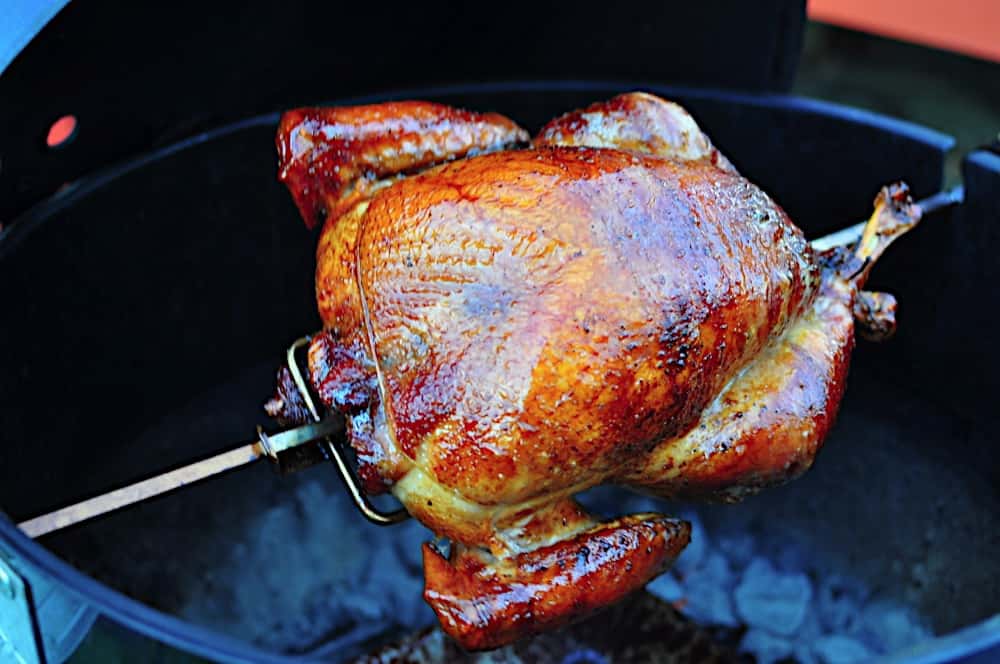
Jump to:
Why Dry Brine a Turkey?
My first trick is to dry brine the turkey. For years, my gold standard for turkey brines was the apple cider brine from Weber's Art of the Grill by Jamie Purviance. I am a complete convert to dry brines now, and I wanted to come up with a dry brine that uses the same flavor profile. I have most of the major ingredients from the Weber brine in my dry rub - salt, a little brown sugar, orange zest, ginger, garlic, and cloves. When combined with a chunk of smoking wood in the grill, you get layers of flavor in the bird - sweet, smoky and salty, with an interesting mix of fruit and spices. This is a turkey that doesn't need gravy to be edible.
*You'll see some bay leaves in the pictures of the dry brine. Ignore them. They're not really there. These are not the bay leaves you're looking for. (Waves hand in dismissive manner.)
**OK, OK, you caught me. I tried to crumble them by hand, and I couldn't break them up small enough to use in my dry brine. I should have used my spice grinder, but I didn't want to get it dirty just for the bay leaves, so I left them out. It tasted great without them.
Don't Overcook the Turkey - Ice the Breast
The next step is cooking the turkey to the appropriate level of doneness. This is tricky. The white meat in the breast should just cook to 160*F so it doesn't dry out. The dark meat in the legs should be cooked above 170*F; it needs extra heat to break down the connective tissue. The problem is - they're both on the same bird, and cooking for the same length of time. I used two techniques to help solve this.
Following the suggestion in Weber's Barbecued Turkey pamphlet I set up the charcoal in a U shape on one half of the grill. This focuses the heat on the turkey's legs, and lessens the heat on the breast.
I also used a trick from Harold McGee. Mr. McGee recommended strapping a couple of ice packs over the breast of the bird after removing it from the refrigerator, so the breasts start out colder than the thighs. His family told him this was "too unappetizing", so he switched to zip-top bags full of ice. Since McGee's On Food and Cooking is the bible of food science, I thought it would be foolish not to take his advice.
Rotisserie Turkey Is the Best Turkey
The turkey is cooked on my rotisserie, of course. Nothing comes close to the crisp, crackling skin from the constant convection caused by the circling bird.*
*Sorry, got stuck in a "C" rut there.
The result of all these steps is the best turkey I've ever made. Can you skip all this detail? Sure. Dry brine the turkey with salt, cook it on the rotisserie, and you'll get a great bird. But if you want to take the bird from great to sublime, have I got the recipe for you...
Inspired by: Lots of different sources.
Equipment
- Grill with Rotisserie attachment (I used a Weber kettle with the Rotisserie attachment. Kettle is this Weber Grill,
and rotisserie is this Weber charcoal kettle rotisserie
)
- Aluminum foil drip pan (11"x13", "turkey size", or whatever fits your grill)
- Cotton twine
- Gallon zip-top bag full of ice (optional)
- Instant Read Thermometer
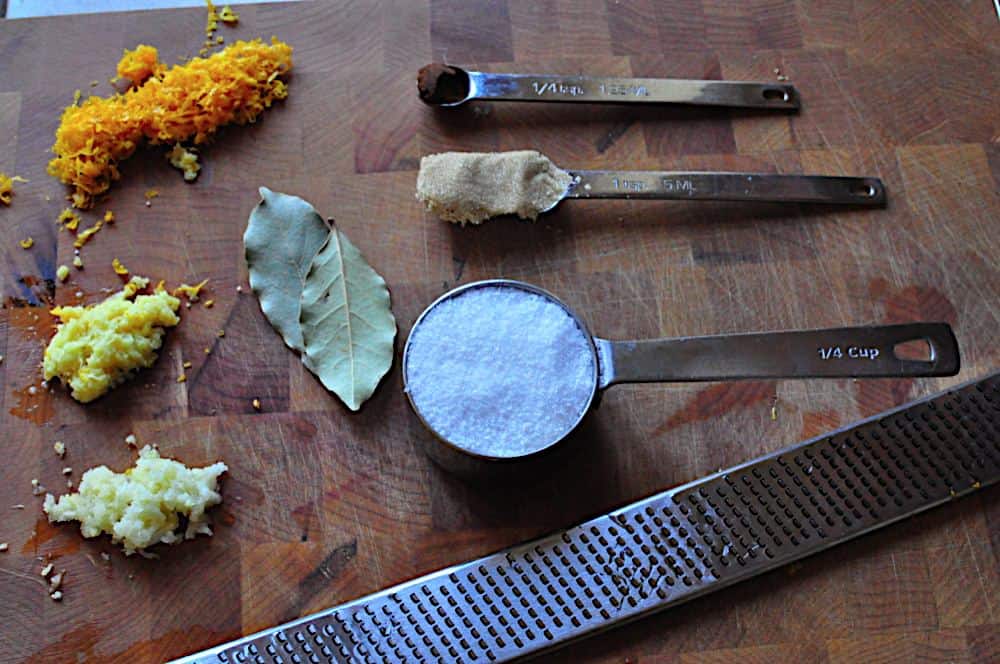
Ingredients
- 12 to 14 lb Turkey
- fist sized chunk of smoking wood (hickory, oak, pecan or a fruit wood; I love oak wine barrel staves
)
Dry Brine Ingredients
- ¼ cup kosher salt (I used Diamond Crystal; reduce to 3 tablespoon if using Mortons, because it is denser).
- Zest of 1 orange (save the orange, cut in half and wrapped in plastic wrap to stuff the turkey)
- 1 teaspoon brown sugar
- 1 teaspoon grated fresh ginger (about a ½ inch piece)
- 1 teaspoon grated fresh garlic (2 cloves)
- ½ teaspoon fresh ground black pepper
- ¼ teaspoon ground cloves
How to grill a Rotisserie Turkey, Dry Brined with Orange and Spices
Note: for an overview of the technique, see my rotisserie poultry post.
Dry brine the turkey
1 to 3 days before it is time to cook, dry brine the turkey. Mix the dry brine ingredients in a small bowl, then sprinkle and rub evenly over the turkey. Make sure to rub some inside the cavity of the turkey as well. Put the turkey on a rack over a roasting pan or baking sheet, and cover with plastic wrap. Refrigerate, removing the plastic wrap the night before cooking to allow the skin to dry. (If you are only dry brining for 24 hours, skip the plastic wrap.)
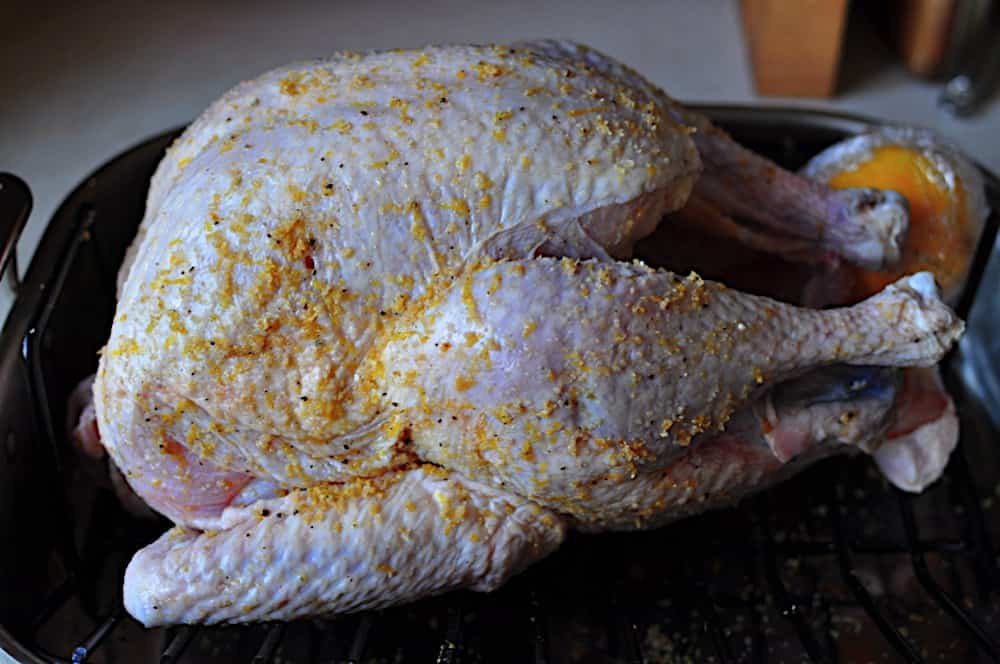
Prep the Turkey
One hour before cooking, remove the turkey from the refrigerator. Stuff the turkey with the halves of the orange, then truss and skewer with the rotisserie spit. Put the zip lock bag full of ice on the breast, not touching the legs or drumsticks, to chill the breast meat until cooking. Put the wood chunk in a bowl of water to soak.
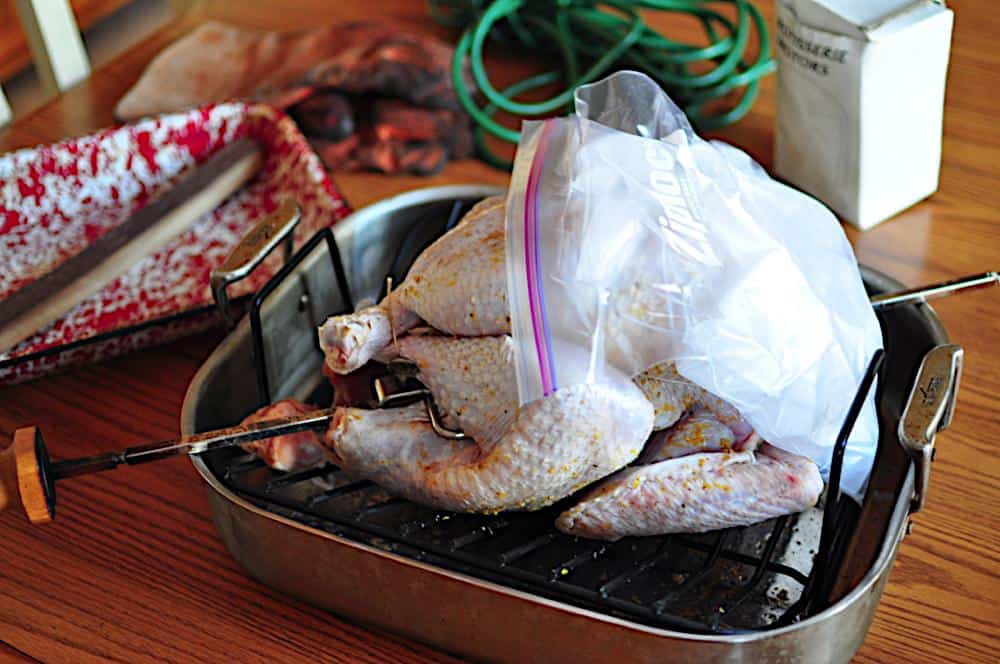
Charcoal Grill Rotisserie Setup
Prepare the grill for rotisserie cooking on indirect medium heat. For my Weber kettle, I light a chimney ¾ full of charcoal and wait for it to be covered with ash. Then, instead of pouring it in my usual two piles on the side of the grill, I pour it in a U shape at one end of the grill (see picture below). I put the drip pan in the middle of the U of charcoal. Finally, put the wood chunk on top of the charcoal, and give it five minutes to start smoking. (More details here: My Rotisserie Basic Technique Post).
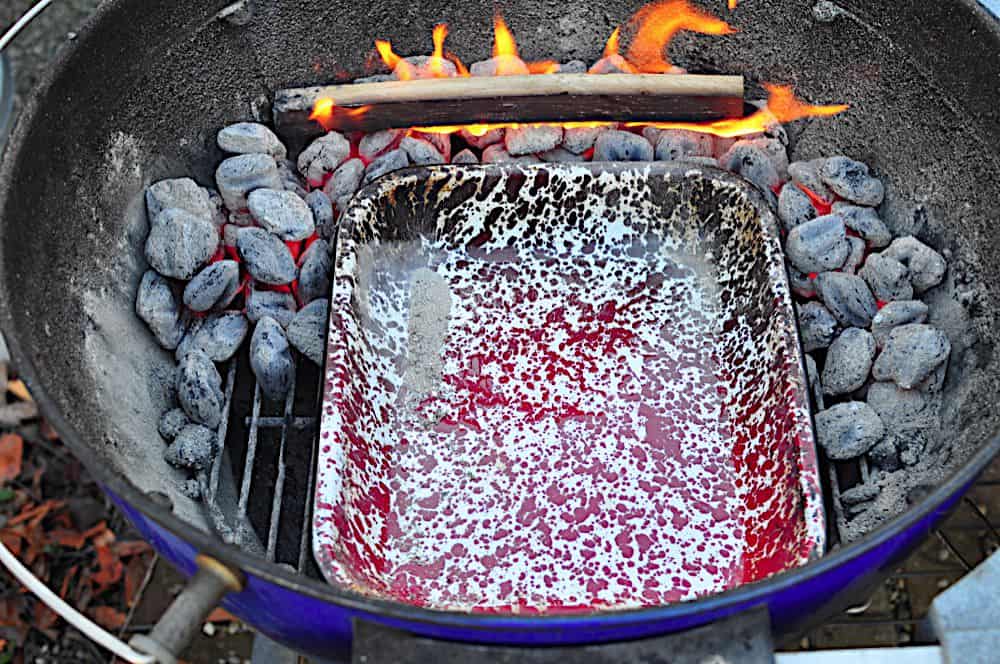
OR: Gas Grill Rotisserie Setup
Set the grill up for rotisserie cooking at indirect medium heat (325*F to 350*F). If you can, put all the heat on one side of the grill - instead of two outside burners on medium, set one outside burner on high, and leave the other one off - this concentrates the heat on the legs, which we want to cook more than the breast. For my Weber Summit, I remove the grates, preheat the grill on high for 15 minutes, then turn off all the burners except burner #6, right next to the smoker burner. I leave burner #6 on high, turn the smoker burner on high, and set the infrared rotisserie burner to medium. The drip pan goes in the middle, over the unlit burners.
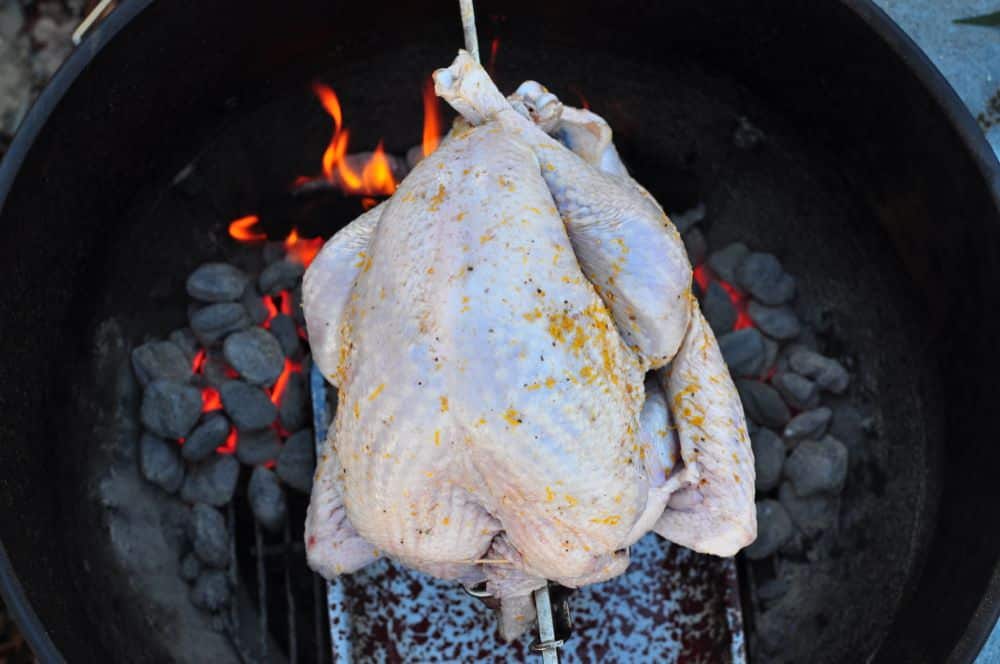
Cook the turkey
Put the spit on the grill, with the leg side of the bird inside the "U" of coals. Cook the turkey with the lid closed; it will take 2 to 3 hours (usually about 2 ½ hours for a 12 pound turkey). Every hour, add 24 fresh charcoal briquettes to the grill, nestling them into the burning charcoal. Start checking the temperature in the breast with an instant read thermometer at 2 hours. The turkey is done when the breast meat registers 155*F to 160*F in its thickest part. Remove the turkey from the grill, remove the spit from the turkey, and cut the trussing twine loose. Let the turkey rest for 15 to 30 minutes before carving.
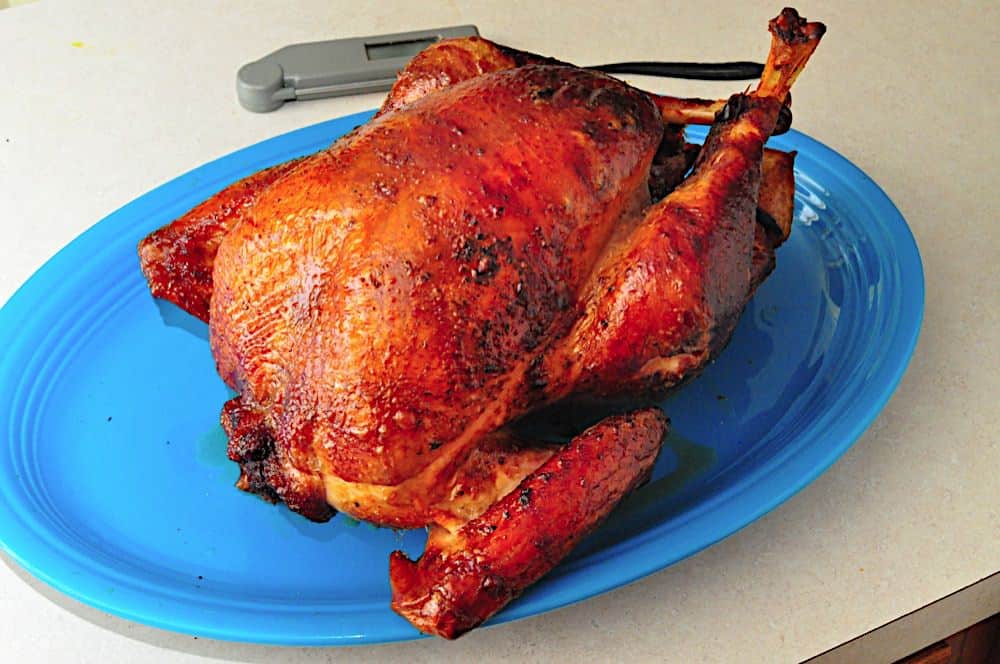
Carve the turkey and serve
If you have a favorite way of carving a turkey, go ahead and use it. My preferred method: Cut the legs free from the body of the bird, and cut the drumsticks away from the thighs. I leave the drumsticks whole (my favorite part!) and slice the meat from the thighs in ½" slices for dark meat lovers. Next, I cut the entire breast half from one side of the bird by working my knife down the keel bone from the top down to the wing, following the inside of the ribcage. Once the breast half is free of the bird, it is easy to slice into ½" thick slices on my carving board. I repeat with the other breast half. Finally, I cut each wing away from the carcass, and separate the drumette from the wing, and the wing from the wingtip. I arrange all these pieces on a platter and serve.
Fresh vs Frozen Turkey
- Fresh vs Frozen: There are two advantages to a fresh turkey. The first is they are rarely pre-brined, which is redundant because of the dry brine. (Watch out for the words "enhanced with a X% solution" or "pre-basted") The second advantage to fresh turkey is no thawing is needed! If you have to get a frozen bird, make sure to leave an extra three days or so to thaw it in the refrigerator before staring the dry brine; start thawing it about a week before you'll need it.
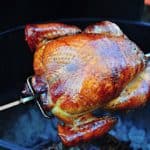
Rotisserie Turkey, Dry Brined with Orange and Spices - Recipe
- Total Time: 27 hours
- Yield: 12 servings 1x
Description
Rotisserie Turkey Dry Brined with Orange and Spices. My go-to Thanksgiving turkey, the one I make every year.
Ingredients
- 12 to 14 lb Turkey
- fist sized chunk of smoking wood (hickory, oak, pecan or a fruit wood; I love oak wine barrel staves
)
Dry Brine Ingredients
- ¼ cup kosher salt (I used Diamond Crystal; reduce to 3 tbsp if using Mortons, because it is denser).
- Zest of 1 orange (save the orange, cut in half and wrapped in plastic wrap to stuff the turkey)
- 1 teaspoon brown sugar
- 1 teaspoon grated fresh ginger (about a ½ inch piece)
- 1 teaspoon grated fresh garlic (2 cloves)
- ½ teaspoon fresh ground black pepper
- ¼ teaspoon ground cloves
Instructions
- Dry Brine the Turkey (For at Least a Day): 1 to 3 days before it is time to cook, dry brine the turkey. Mix the dry brine ingredients in a small bowl, then sprinkle and rub evenly over the turkey. Make sure to rub some inside the cavity of the turkey as well. Put the turkey on a rack over a roasting pan or baking sheet, and cover with plastic wrap. Refrigerate, removing the plastic wrap the night before cooking to allow the skin to dry. (If you are only dry brining for 24 hours, skip the plastic wrap.)
- Prep the Turkey: One hour before cooking, remove the turkey from the refrigerator. Stuff the turkey with the halves of the orange, then truss and skewer with the rotisserie spit. Put the zip lock bag full of ice on the breast, not touching the legs or drumsticks, to chill the breast meat until cooking. Put the wood chunk in a bowl of water to soak.
- Charcoal Grill Rotisserie Setup: Prepare the grill for rotisserie cooking on indirect medium heat. For my Weber kettle, I light a chimney ¾ full of charcoal and wait for it to be covered with ash. Then, instead of pouring it in my usual two piles on the side of the grill, I pour it in a U shape at one end of the grill (see picture below). I put the drip pan in the middle of the U of charcoal. Finally, put the wood chunk on top of the charcoal, and give it five minutes to start smoking.
- OR: Gas Grill Rotisserie Setup: Set the grill up for rotisserie cooking at indirect medium heat (325*F to 350*F). If you can, put all the heat on one side of the grill - instead of two outside burners on medium, set one outside burner on high, and leave the other one off - this concentrates the heat on the legs, which we want to cook more than the breast. For my Weber Summit, I remove the grates, preheat the grill on high for 15 minutes, then turn off all the burners except burner #6, right next to the smoker burner. I leave burner #6 on high, turn the smoker burner on high, and set the infrared rotisserie burner to medium. The drip pan goes in the middle, over the unlit burners.
- Cook the turkey: Put the spit on the grill, with the leg side of the bird inside the "U" of coals. Cook the turkey with the lid closed; it will take 2 to 3 hours (usually about 2 ½ hours for a 12 pound turkey). Every hour, add 24 fresh charcoal briquettes to the grill, nestling them into the burning charcoal. Start checking the temperature in the breast with an instant read thermometer at 2 hours. The turkey is done when the breast meat registers 155*F to 160*F in its thickest part. Remove the turkey from the grill, remove the spit from the turkey, and cut the trussing twine loose. Let the turkey rest for 15 to 30 minutes before carving.
- Carve the turkey and serve: If you have a favorite way of carving a turkey, go ahead and use it. My preferred method: Cut the legs free from the body of the bird, and cut the drumsticks away from the thighs. I leave the drumsticks whole (my favorite part!) and slice the meat from the thighs in ½" slices for dark meat lovers. Next, I cut the entire breast half from one side of the bird by working my knife down the keel bone from the top down to the wing, following the inside of the ribcage. Once the breast half is free of the bird, it is easy to slice into ½" thick slices on my carving board. I repeat with the other breast half. Finally, I cut each wing away from the carcass, and separate the drumette from the wing, and the wing from the wingtip. I arrange all these pieces on a platter and serve.
- Prep Time: 1 day
- Cook Time: 3 hours
- Category: Sunday Dinner
- Method: Rotisserie
- Cuisine: American
What do you think? Questions? Other ideas? Leave them in the comments section below.
Related Posts
Basic Rotisserie Turkey
Rotisserie Turkey, Dry Brined with Orange and Spices
Rotisserie Turkey - The Big Turkey
Rotisserie Turkey Wrapped With Bacon
Rotisserie Turkey with Cajun Dry Brine
Rotisserie Turkey Breast with Basic Dry Brine
Rotisserie Turkey Breast with Honey Bourbon Glaze
Click here for my other rotisserie recipes.
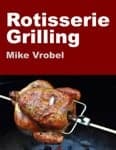 Check out my cookbook, Rotisserie Grilling. Check out my cookbook, Rotisserie Grilling. |
Everything you could ask about the rotisserie,
plus 50 (mostly) new recipes to get you cooking.
It's a Kindle e-book, so you can download it and start reading immediately!
*Enjoyed this post? Want to help out DadCooksDinner? Subscribe to DadCooksDinner using the RSS or Email options on the right, link to this post from your blog, recommend DadCooksDinner to your friends, or buy something from Amazon.com through the links on this site. (Like my Rotisserie Grilling cookbook...)

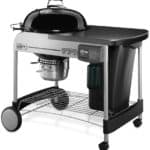
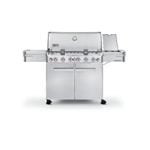


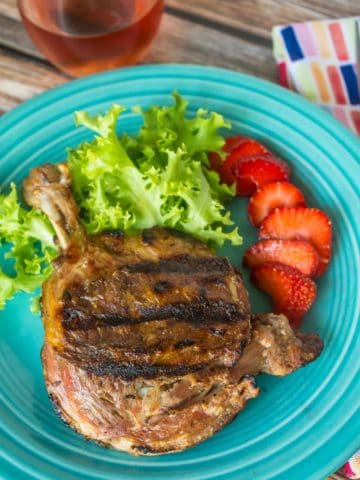
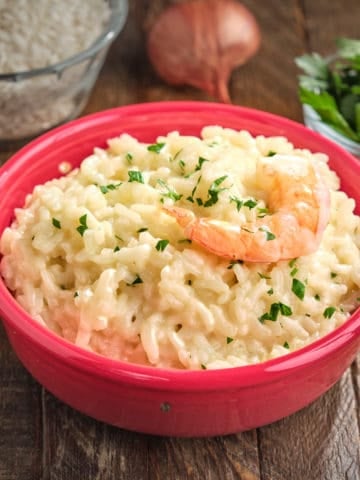
Mike V @ DadCooksDinner
I prefer the charcoal version - you get better browning on the skin, and a little more smoky flavor. That said, I usually cook two birds, one on charcoal and one on gas, and they both come out great.
Good luck, and remember, the key to Thanksgiving is having a plan. If you know what you need to do, and when you need to do it, you'll be ready.
Richard H Marshall
Mike,Once again you have inspired the amature chef hiding inside all of us.This year,mother asked my wife and I to host Thanksgiving dinner(panic)and instantly thought of the rotisserie for the bird.My question for you,do you prefer the gas or charcoal version.I am going for a straight wet brine,such as your old school weber apple juice spiced brine.I am leaning on the charcoal,but the convienience of gas.....im torn!
Anonymous
Great, thanks for the reply. I will definitely be using this for Thanksgiving!!!
-Margaret W
MikeV @ DadCooksDinner
@Margaret W:
Too salty? No, I've never had that complaint.
Now, saltiness is one of those things that different people taste more or less of; If you're really sensitive to salt, you might find this a bit salty. But some members of my family are very sensitive to salt, and they enjoyed the turkey last year, so I think you'll be fine.
Anonymous
Your recipe and technique looks amazing, I am thinking about using it for Thanksgiving this year. One question, after looking at other dry brining recipes...does yours turn out a bit salty since you do not rinse the brine mixture off the bird before cooking?
Thank you
-Margaret W.
MikeV @ DadCooksDinner
@Yossi:
A 20 pound turkey is pushing it. The spit will be fine; I'm worried about space. I *think* it will fit, but just barely. I don't think I ever cooked a bird above 14-16 pounds in my Genesis. (Back when I owned one).
I don't like a lot of smoke in my turkey - I'd use a fist sized chunk of wood or two, or 1 to 2 cups of soaked chips.
Yossi
2 questions.
Do you think that the webber rotisserie attachment and genesis 310 can handle a 20lb turkey if it is trussed well and loaded onto the spit tightly?
How much smoke do you think should be used with a turkey?
Yossi
For some reason when I rotisserie birds (chicken and cornish hens) I always put a drip pan underneath and there didnt seem to be much there. (this was obviously not the case when I rottisseried duck which i pked holes in the skin and had about 1.5 inches of drippings). Should i poke holes in the skin of my chickens to increase the drippings? or what would be the reason that I dont get the usual drippings?
MikeV @ DadCooksDinner
@Yossi:
Duck has a LOT more fat under the skin than chicken and cornish game hens. That's where the drippings come from. Chicken and cornish hens will have less than a duck.
I was used to the drippings from chicken, and was amazed the first time I cooked a duck how much fat was rendered from it. (To make matters worse, I slipped, and dumped the pan full of hot duck fat into my grill...)
Yossi
If you dont recommend brining kosher poultry, what do you recommend to do for the "brine" step for kosher poultry? Perhaps skip the salt ingredient? or maybe minimize the amount of salt?
MikeV @ DadCooksDinner
@Yossi:
If you're using a kosher turkey, don't add any more salt. Unfortunately, that means you lose salt's ability to pull the flavors into the meat while you brine.
With a kosher bird, skip the brining step, and the salt in the rub; you can rub the bird with the other spices ahead of time, but it will be just about as effective to rub them on right before cooking.
It won't be as thoroughly flavored with the herbs, but the turkey will still taste great.
Yossi
I have a question about brining in general. Is it necessary to brine kosher birds? Since salting is part of the koshering process this may cause the bird to be "over"brined, and too salty.
Have you heard anything related to this before? Do you have any experience with kosher birds?
Please advise as I want to get the most out of a brine but dont want to ruin the bird.
MikeV @ DadCooksDinner
@Yossi:
You should NOT brine kosher birds. You are correct, the koshering process results in a pre-brined bird; brining it again would be too salty.
I once used this to my advantage, when a last minute illness cancelled our Thanksgiving plans. I picked up a kosher bird the day before Thanksgiving, and didn't have to worry about brining - it was ready to cook.
MikeV @ DadCooksDinner
@Dan: Thank you! The ice pack trick helps; I'm a dark meat fan, so I want my legs and thighs cooked to 175*F or so. I don't want to overcook the breast meat while I'm doing it.
And I have a hard time with all the talk about breasts myself. There was something I was writing that seemed like it would get me into sexual harassment class if I said it at work. It's a good thing I'm talking about poultry...
Daniel
The icepack on the breast idea(gosh that sounds a borderline inappropriate) is an exceptional one, thanks for sharing Mike! You've outdone yourself this Thanksgiving with the insights you're giving to your readers.
Dan
Casual Kitchen